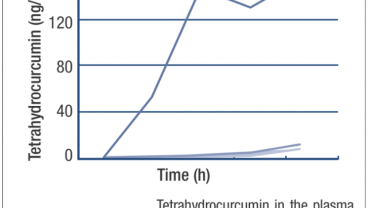
There are only a few natural products that have demonstrated the wide range of protective properties as curcumin. Some of the challenges with curcumin are its poor solubility low intestinal absorption rapid metabolism and rapid systemic elimination.1 Many different supplement manufacturers have tried numerous methods to enhance absorption and bioavailability with piperine nanoparticles or emulsions.
Turmerics three main bioactive components are curcumin desmethoxycurcumin and bisdemethoxycurcumin. These curcuminoids have many biological effects including anti-inflammatory antioxidant antitumor antibacterial and antiviral properties. However the poor circulating bioavailability of the curcuminoids limits their biological effects in vivo.2 Recently there has been significant attention on tetrahydrocurcumun which is the most powerful metabolite of the curcuminoids.3
Tetrahydrocurcumin is not typically found in turmeric extract powders containing 95% curcuminoids used in dietary supplement products but it appears in the plasma following ingestion of curcuminoids.4 Tetrahydrocurcumin plays an important role in the antioxidant mechanism of curcumin and has been shown to be the most potent antioxidant of the curcuminoids.5 In a January 2014 study in the Nutrition Journal several trademarked curcumin formulas were analyzed for their bioavailability. Although all of these formulations did enhance absorption of the curcuminoids none of them significantly produced tetrahydrocurcumin in vivo.4
The free radical scavenging ability was compared in a series of studies of various curcuminoids including curcumin bisdemethoxycurcumin and tetrahydrocurcumin.6 As a result tetrahydrocurcumin was demonstrated as being the most effective followed by curcumin and bisdemethoxycurcumin.
Curcumin and tetrahydrocurcumin have distinct benefits over one another and it would make sense to have both and not just one. It would be best to consume a bioavailable curcumin product that produces significant levels of this metabolite in vivo. Most studies have indicated that tetrahydrocurcumin exhibits a higher antioxidant activity while curcumin exhibits both pro-oxidant and antioxidant properties.7
Several independent studies reported the significant antioxidant effects of tetrahydrocurcumin.589 One study evaluated the antioxidant activity of the curcuminoids and tetrahydrocurcumin and found that tetrahydrocurcumin had the strongest antioxidant activity among all curcuminoids and therefore must play an important role in the antioxidant mechanism of curcumin in vivo.4
A highly absorbed curcumin formula would be the best choice to reduce peripheral inflammation directly. This may include neurodegenerative diseases cardiovascular diseases osteoarthritis various cancers benign prostatic hypertrophy diabetic microangiopathy and retinopathy anterior uveitis maculopathy and glaucoma.
Tetrahydrocurcumin has been shown to have specific neuroprotective properties. One study demonstrated a protective effect of tetrahydrocurcumin against oligomeric amyloid-I²-induced toxicity.10 This antioxidant activity may have a neuroprotective effect in Alzheimers disease.
Oxidative stress has been associated with many diseases including diabetes. A separate study demonstrated that tetrahydrocurcumin increased the total number of insulin binding sites resulting in a significant increase in plasma insulin. Note that this effect was superior to that of curcumin.11
Tetrahydrocurcumin also demonstrates powerful cardioprotective properties. In a study in Hypertension Research tetrahydrocurcumin alleviated hypertension and reversed the effects of aortic wall thickness and stiffness and oxidative stress.12 Therefore tetrahydrocurcumin may be considered as a protective agent against cardiovascular alterations under nitric oxide-deficient conditions.
Curcumin is metabolized to tetrahydrocurcumin and both of these compounds have distinct protective properties. Curcumin binds and modulates a wide array of targets whereas tetrahydrocurcumin is a superior antioxidant but lacks some of the anti-inflammatory and pro-oxidant activities of curcumin.
Curcum-Evail is the only curcumin formula that produces the potent metabolite tetrahydrocurcumin in vivo. It remains to be seen whether taking tetrahydrocurcumin is better than a formula that naturally produces significant levels of plasma tetrahydrocurcumin in vivo from the parent compounds.
Research demonstrates tetrahydrocurcumin has potent antioxidant properties but if taken by itself what does this metabolite get metabolized into? Will it appear as unconjugated tetrahydrocurcumin or some other metabolite? Will it have the same effect as what is being produced in vivo from the parent compounds?
Curcum-Evail is a patent pending bioavailable curcuminoid formulation in a softgel from Designs for Health. It is manufactured via a new proprietary emulsification process that uses all-natural ingredients including vitamin E medium chain triglycerides (MCT) and lecithin without the use of potentially harmful surfactants.
By Michael Jurgelewicz DC DACBN DCBCN